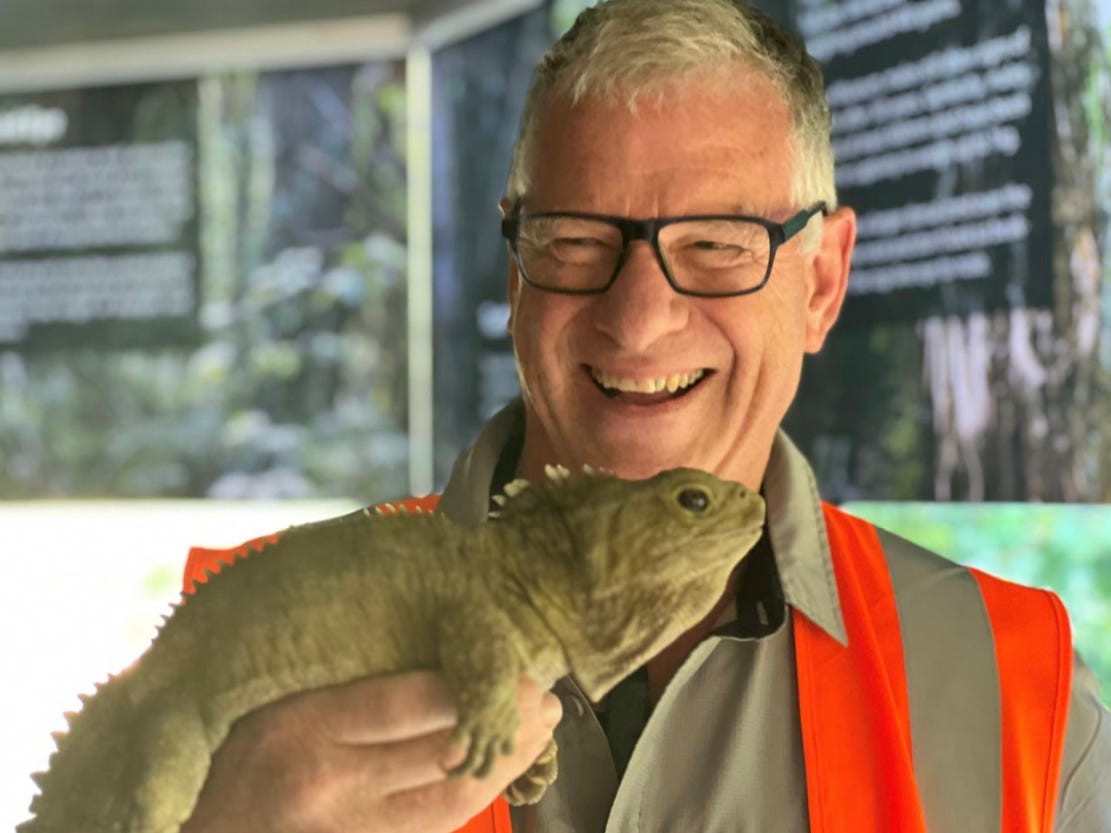Tuatara guru: Surprise babies, missing Henry, and new enclosure disappointment
“In my last weeks there I did lots of checks in the enclosure for living animals hiding under the logs because when the wee guys hatch, they head for cover and hide."
What to help us continue to shine a light on Southland? How about joining as a paid subscriber/supporter.
Invercargill’s famed former tuatara carer Lindsay Hazley has been retired for just over a year now. Logan Savory caught up with Hazley to chat about last week’s surprise tuatara baby find, as well as his disappointment about not being part of the design of Invercargill’s new tuatara enclosure.
Tuatara expert Lindsay Hazley believes the surprise babies found at Invercargill’s museum demolition site are about 12 to 18 months old given their size.
Hazley spent 52 years working with the tuatara at the Southland Museum before retiring in April last year.
One of his final tasks was to remove the tuatara from the museum and relocate them in the lead up to demolition of the Southland Museum and Art Gallery building at Queens Park.
It included clearing the nesting sites.
However last week the Invercargill City Council revealed demolition workers had discovered four baby tuatara in the former enclosure.
The Tribune understands a fifth baby tuatara has since been found.
“In my last weeks there I did lots of checks in the enclosure for living animals hiding under the logs because when the wee guys hatch, they head for cover and hide,” Hazley told The Tribune.
“So, I did lots of sweeps and I gave the all clear there was no babies in there.
“The females use the same nesting site, so prior to that I dug up the areas where they would normally lay, and I did find eggs.”
Hazley had in recent years been under instruction from the Department of Conversation to not breed any more tuatara. At one-point Hazley had over 100 tuatara.
Rather than euthanising the eggs when they were laid, Hazley would leave them in the ground and get the enclosure dry so that the eggs would dehydrate and die naturally.
“But the roof did have leeks,” Hazley said.
“So, there is one or two spots in that enclosure where the water might have been leaking and the smart-arse females might have actually gone to those spots to lay their eggs, different to the normal nesting sites.”
Those eggs obviously were not found when the enclosure was cleared.
Hazley said it can take a year, a year and half for the eggs to hatch.
“Going by the size of the tuatara that I saw in the hands, they are probably a year old, if not a year and half.”
“Normally when they are born, they are 80-90mm long and weigh four or five grams. Where these ones are all getting close to nine or 10 grams and 100mm-plus from what I read.”
Hazely said tuatara are survivors and could go about three months without eating when they hatch.
After that there would have been beetles, slaters, spiders, and other bugs around for the baby tuatara to feast on.
Hazley was not surprised to hear of the find at the demolition site last week given his own past experiences with eggs.
After Hazley had been told to halt breeding tuatara and to not hatch a bunch of tuatara eggs he already had, he took them out to another location and buried them in an enclosure he had there.
“I recorded all the air temperature and moisture content and after a year there was about 14 eggs left that were still viable, the rest had rotted away.
“Just on two years later 14 of them hatched. That never got publicised.
“That was two years in the ground and the temperatures went down to two degrees, which is again fantastic science gathering that data.”
Hazley thought he was recording the temperature to see why the eggs failed to hatch.
“What showed us is they in fact survive here in Southland.”
He felt it was the predators that was the biggest threat, not the climate.
“They are survivors, they can go two years in the ground, a good healthy tuatara can go several years and not eat and will still survive.”

Hazley had been told to stop his tuatara breeding programme in Invercargill because the genetic representation was getting too great.
“In science you don’t want all the same genetics. My breeding stock at that time, the genetics were getting saturated, as in too many,” Hazley said.
Henry, Lucy, Mildred, and Albert were the main adults in Hazley’s breeding programme.
“Henry doesn’t have that many surviving kids at all, he entered the breeding programme late. He had quite a high mortality rate with his off-spring.
“Albert was the main stud; he probably has over 80 kids. His genetics were well represented in captivity and that was another reason for stopping him breeding.
“I had second generation breeding as well, so Lucy and Mildred’s kids were all at a breeding age as well and were also breeding.”
Hazley watches on from a distance
For 52 years Hazley was the face of Invercargill’s connection with the tuatara.
You could say him and Henry - Invercargill’s most high-profile tuatara - became pretty good mates.
Although Hazley jokingly concedes he’s not exactly sure how old Henry is.
“For about 30 years working there I said he was 100. He would be no younger than 110, he could be 120, he could be older.”
“They may live to 200 to 250 years.”
Hazley hasn’t seen Henry since he retired from the role.
Infact, he hasn’t had anything to with the tuatara he once built such a report with.
Hazley admits to some disappointment he wasn’t called on to help with the design of the new tuatara enclosure at Queens Park which is about to open to the public.
He has followed the development, and last week’s baby tuatara find, via the media like much of the public.
He has stayed involved with tuatara in a small capacity as a consultant at the Wildlife Centre in Fraz Josef.
Hazley felt it was “crazy” that his knowledge hasn’t been utilised in his home city through the design of the new enclosure. He has been invited to the official opening this month but isn’t planning on attending.
The Invercargill City Council has worked with tuatara experts in Wellington to help with the design of the tuatara enclosure.
“Wellington is a different climate,” Hazley said, admitting he would have loved to be consulted.
“I’ve designed five other enclosures around the country and built the world’s most successful one, so I am very disappointed I wasn’t used or shown any designs through the process.”
Once it is open he will head a long a visit the tuatara.
Invercargill’s new tuatara enclosure, which is set to open to the public on Saturday June 8.
The new tuatara enclosure, situated in the Queens Park animal reserve, will open to the public at 10am on Saturday with a range of celebrations planned, including free face painting, tuatara talks, rock hunts, a sausage sizzle and more.
Hazley hasn’t been shown the plans of the tuatara enclosure but from what he has picked up at this point he admits he has some doubts with the design and will be interested in how it works for the tuatara.
He was surprised by the open roofing concept.
“In 1974 we built an enclosure that had an open roof with mesh. They hibernated for about eight months of the year, and we had really bad frosts for about two weeks during winter and our female [tuatara] Stephanie died.
“I put a roof over it and that’s when everything went [well].”
He said insulated borrows also “scared” him.
“Tuatara normally are in burrows about 300mm under the ground, if you go too deep you don’t get the seasonal sensory of the seasons.
“So, if they go too deep, they don’t sense when the summer is coming, and they may stay under the ground a lot longer. It can actually result in going onto hibernation and not waking up if it’s too deep.”
“These insulated burrows would stop that but I’m still a wee bit nervous… if it gets really cold when it does get warm, females maybe slower to come out because they are expecting the immediate temperatures above the surface. It will be interesting, and something time will sort out.”








It is very disappointing that ICC did not appreciate the skills and expertise of Lindsay!. I personally am disgusted. And can I ask how much the expertise of the Wellington perspective cost. !!
ICC not valuing the very staff that have been loyal for many years: its not good business acumen, nor good decision making for good collegial relationships.
How many years does it take to be respected and appreciated- one has to consider!!!!
I’m sorry your expertise and knowledge weren’t valued and called upon for the new enclosure. You’re as much a part of the tuatara story in Invercargill as the tuatara are. I remember fondly having one of them visit my room when your son was in my class. What a treat.